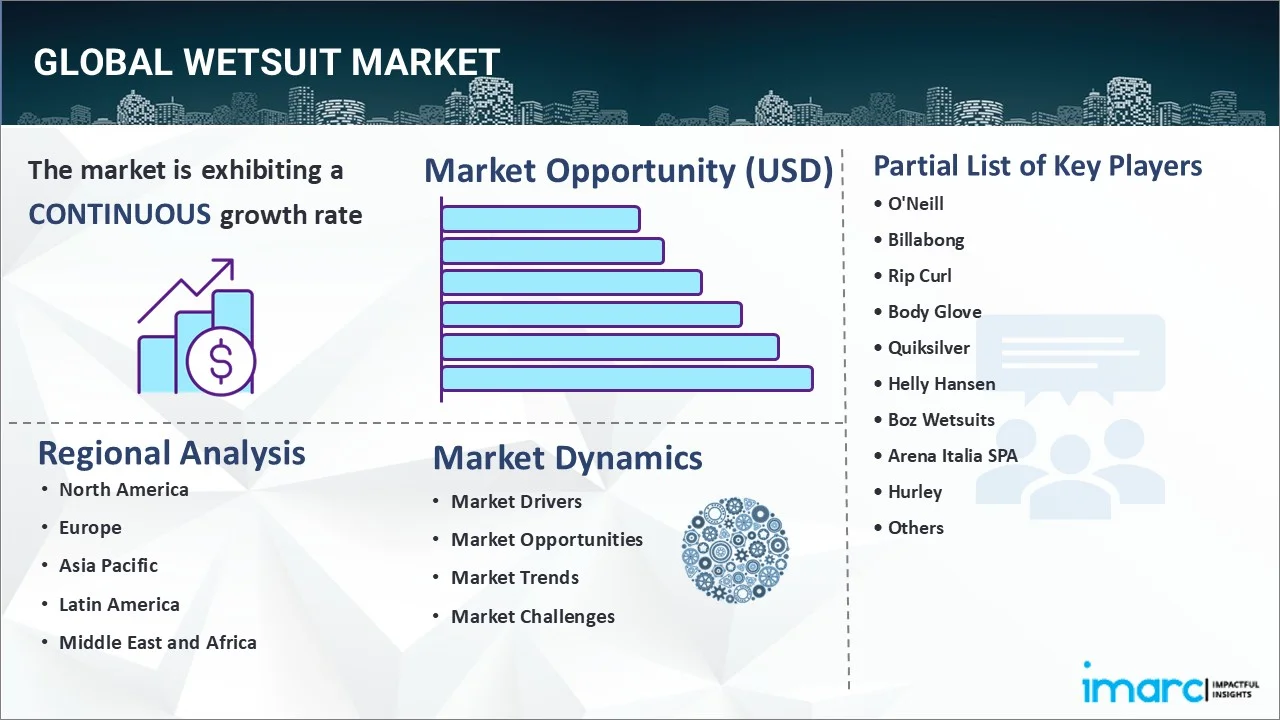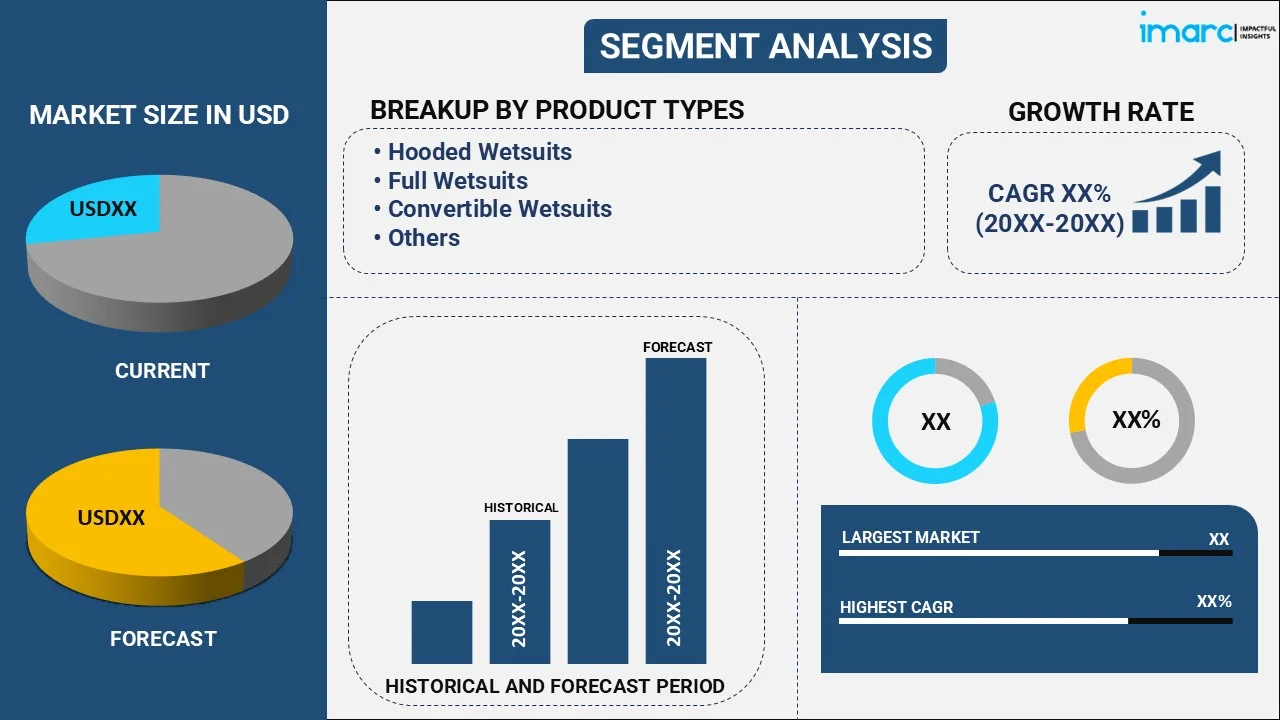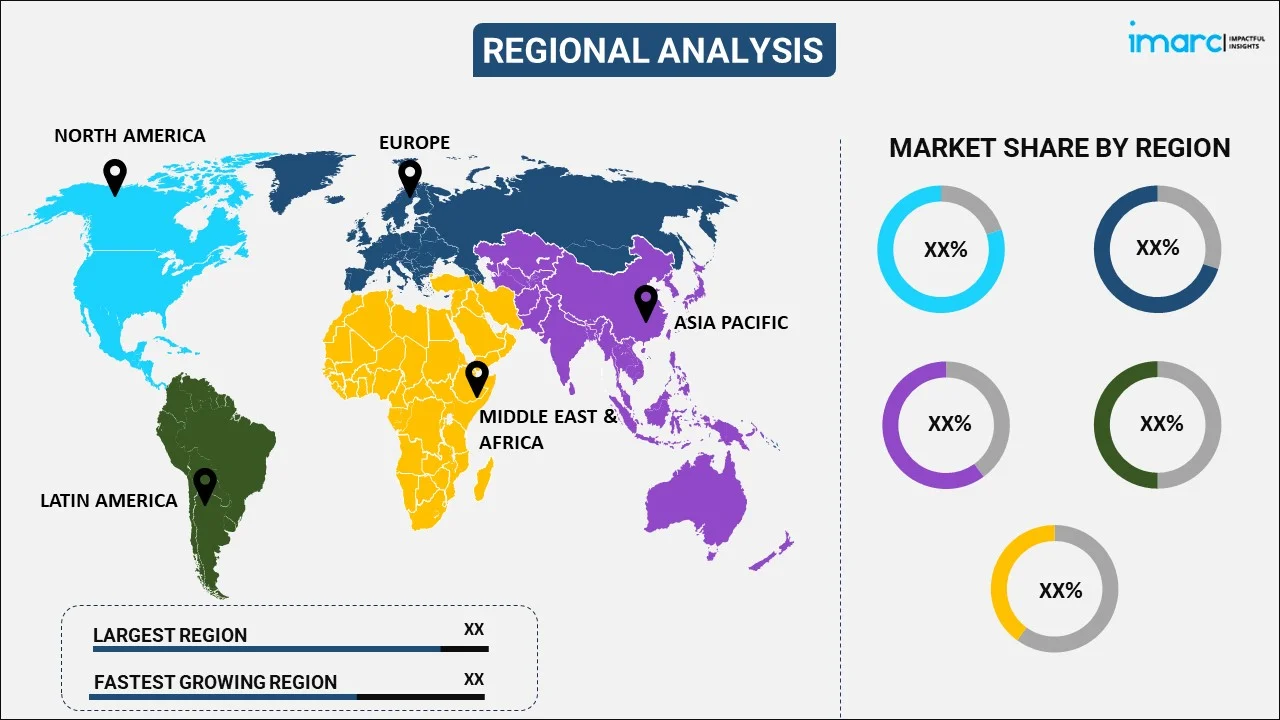
Wetsuit Market Report by Product Type (Hooded Wetsuits, Full Wetsuits, Convertible Wetsuits, Sleeveless Wetsuits, Shortly/Spring Wetsuits, and Others), Thickness (1mm-2mm, 2mm-3mm, 3mm-4mm, 4mm-5mm, > 5mm), End User (Male, Female, Kids), Application (Surfing, Scuba Diving, Triathlon, and Others), Distribution Channel (Sports Variety Stores, Third Party Online Channels, Direct to Customer Channels, Franchised Stores, Modern Trade Channels), and Region 2025-2033
Wetsuit Market Size:
The global wetsuit market size reached USD 1,432 Million in 2024. Looking forward, IMARC Group expects the market to reach USD 2,163.6 Million by 2033, exhibiting a growth rate (CAGR) of 4.7% during 2025-2033. The increasing participation in water sports, advancements in wetsuit materials and technology, rising health and fitness awareness, growing tourism in coastal areas, and the expansion of e-commerce platforms are some of the major factors driving the growth of the market.
|
Report Attribute
|
Key Statistics
|
|---|---|
|
Base Year
|
2024
|
|
Forecast Years
|
2025-2033
|
|
Historical Years
|
2019-2024
|
|
Market Size in 2024
|
USD 1,432 Million |
|
Market Forecast in 2033
|
USD 2,163.6 Million |
| Market Growth Rate 2025-2033 | 4.7% |
Wetsuit Market Analysis:
- Major Market Drivers: The growing popularity of water sports including surfing, diving, and snorkeling represents the major driver of the market. As more people engage in these activities, the demand for high-quality wetsuits increases. Advancements in wetsuit materials, such as neoprene and other synthetic rubbers, have enhanced comfort, flexibility, and thermal insulation, making them more appealing to enthusiasts.
- Key Market Trends: The development of eco-friendly and sustainable products represents a key trend in the market. Manufacturers are increasingly using recycled materials and environmentally friendly production processes to meet the growing consumer demand for sustainable options. This trend aligns with the broader global shift toward environmental consciousness and sustainability.
- Geographical Trends: North America accounts for the largest region in the wetsuit market growth. The increasing popularity of water sports, technological advancements in wetsuit materials, growing coastal tourism, and heightened health and fitness awareness are driving the growth of the market across the region.
- Competitive Landscape: Some of the major market players in the wetsuit industry include O'Neill, Billabong, Rip Curl, Body Glove, Quiksilver, Helly Hansen, Boz Wetsuits, Arena Italia SPA, Hurley, Patagonia, Hyperflex Wetsuits, Speedo, GUL, Typhoon, and Isurus, among many others.
- Challenges and Opportunities: The market faces several changes such as high production costs, environmental concerns regarding synthetic materials, and market saturation in developed regions. However, the market also faces various opportunities such as the development of eco-friendly wetsuits using sustainable materials and advancements in technology enhancing comfort and performance.

Wetsuit Market Trends:
Increasing Popularity of Water Sports
The rising engagement in activities like surfing, diving, and snorkeling fuels the demand for wetsuits. As more individuals participate in these sports, the need for high-quality, durable wetsuits grows. According to the Surf Industry Members Association, surfing is the fastest-growing water sport in the top 25 fastest-growing sports using data from the 2023 SFIA Report. And for action sports, that meant Skateboarding came in at 59.1%, Surfing at 28.5%, and Snowboarding at 14.5%. According to the International Surfing Association, for years, the ISA has run a worldwide coaching Program for certifying StandUp Paddle (SUP) coaches, instructors, and judges/event officials for both ocean and flat-water racing in all bodies of water. The ISA has certified over 5,000 Coaches worldwide from over 35 countries, 700 of which are specialized in SUP. This is further boosting the wetsuit market statistics significantly.
Growing Health and Fitness Awareness
The growing focus among people on health and fitness is seeking outdoor activities, including water sports, as a means of physical exercise and recreation which is boosting the demand for wetsuits. According to USA Today, in fact, as a full body workout, swimming is better than many land-based exercises in many ways. Swimming is a better form of exercise than many other exercises, especially for heart disease prevention, primarily because exercise has been shown to work both the heart and lungs and thereby train the body to use oxygen more efficiently, as per Harvard Medical School. For instance, in May 2023, Orlando startup Phlex is partnering with a global sports sensor company for a new swimming training product. The company, a graduate of the LeAD Lake Nona Sports & Health Tech Accelerator, launched a wearable device for swimmers and coaches with Finland-based Polar Electro. The device allows all levels of swimmers, from casual to competitive, to track a few performance statistics like heart rate, calories burned, and more through Phlex's app. This is expected to fuel the wetsuit market forecast over the coming years.
Significant Technological Advancements in Wetsuit Materials
Innovations in materials, such as enhanced neoprene and other synthetic rubbers, have improved wetsuit flexibility, comfort, and thermal insulation. These advancements make wetsuits more appealing to consumers, driving market growth. For instance, in June 2024, Billabong, the globally recognized surf and lifestyle brand, announced the release of its most sustainable range of wetsuits built-to-date. The groundbreaking project, coined “Upcycler,” has been years in the making, representing a world-first, with a combination of multiple technologies rolled into one wetsuit, now included across their entire performance range. This innovative initiative combines discarded post-consumer textiles for jerseys and wetsuit liners and repurposes post-consumer discarded wetsuits into raw ingredients for the internal rubber. Additionally, Billabong has made a crucial shift by transitioning all synthetic rubber to an all-natural FSC-certified rubber formulation sourced from the Hevea brasiliensis tree. These three major steps mark a significant leap toward creating the most sustainable wetsuits built to date.
Wetsuit Market Segmentation:
IMARC Group provides an analysis of the key trends in each segment of the market, along with forecasts at the global and regional levels for 2025-2033. Our report has categorized the market based on product type, thickness, end-user, application and distribution channel.
Breakup by Product Type:

- Hooded Wetsuits
- Full Wetsuits
- Convertible Wetsuits
- Sleeveless Wetsuits
- Shortly/Spring Wetsuits
- Others
Full wetsuits accounts for the majority of the market share
The report has provided a detailed breakup and analysis of the market based on the product type. This includes hooded wetsuits, full wetsuits, convertible wetsuits, sleeveless wetsuits, shortly/spring wetsuits, and others. According to the report, full wetsuits represented the largest segment.
The demand for full wetsuits is driven by their superior thermal insulation, making them ideal for colder water conditions and extended water sports sessions. They offer enhanced protection against marine life and UV rays, increasing safety and comfort for users. The versatility of full wetsuits makes them suitable for a wide range of water activities, from surfing to diving. Additionally, advancements in materials and design have improved flexibility and fit, boosting their popularity among water sports enthusiasts. For instance, in June 2024, Patagonia, as the industry leader in environmentally and socially responsible surf gear, is proud to share the co-development of a groundbreaking circular solution for wetsuits with Bolder Industries. Earlier this year, Patagonia began collecting end-of-life Yulex® (natural rubber) wetsuits so that they could be broken down at the molecular level by Bolder Industries to be used as carbon black in the dyeing process of future Yulex® wetsuits. Carbon black is used to dye the wetsuits’ recycled nylon lining and accounts for about 15 – 20% of Patagonia wetsuits’ rubber foam. Production of Bolder Industries’ BolderBlack® uses 90%+ less water and emits 90%+ fewer greenhouse gases than traditional carbon black.
Breakup by Thickness:
- 1mm-2mm
- 2mm-3mm
- 3mm-4mm
- 4mm-5mm
- > 5mm
> 5mm holds the largest share of the industry
A detailed breakup and analysis of the market based on the thickness have also been provided in the report. This includes 1mm-2mm, 2mm-3mm, 3mm-4mm, 4mm-5mm, and > 5mm. According to the report, the > 5mm segment accounted for the largest market share.
The demand for wetsuits with thickness greater than 5mm is driven by their superior thermal insulation, essential for cold water and extended diving sessions. These wetsuits are preferred by divers and surfers in colder regions, ensuring prolonged comfort and protection. Additionally, advancements in neoprene technology have enhanced the flexibility and buoyancy of thicker wetsuits, making them more comfortable without compromising mobility. The increasing popularity of cold-water sports and diving expeditions further boosts the demand for thicker wetsuits.
Breakup by End User:
- Male
- Female
- Kids
Male represents the leading market segment
The report has provided a detailed breakup and analysis of the market based on the end user. This includes male, female, and kids. According to the report, the male segment accounted for the largest market share.
The demand for wetsuits among males is driven by their high participation in water sports such as surfing, diving, and snorkeling. Males often seek durable, high-performance wetsuits that offer superior thermal protection and flexibility. The increasing popularity of outdoor and adventure sports, combined with a focus on fitness and health, fuels this demand. Additionally, advancements in wetsuit technology, such as improved neoprene materials and ergonomic designs, enhance comfort and performance, making them more appealing to male consumers.
Breakup by Application:
- Surfing
- Scuba Diving
- Triathlon
- Others
Surfing exhibits a clear dominance in the market
A detailed breakup and analysis of the market based on the application have also been provided in the report. This includes surfing, scuba diving, triathlon, and others. According to the report, surfing accounted for the largest market share.
The demand for wetsuits in surfing is driven by the need for thermal insulation, allowing surfers to stay in the water longer, especially in colder climates. Wetsuits protect against abrasions, UV rays, and marine life, enhancing safety and comfort. The growing popularity of surfing as a sport and recreational activity fuels this demand. Additionally, advancements in wetsuit materials and designs have improved flexibility and fit, catering to surfers' needs for performance and maneuverability. The rise of surf tourism also contributes to market growth.
Breakup by Distribution Channel:
- Sports Variety Stores
- Third Party Online Channels
- Direct to Customer Channels
- Franchised Stores
- Modern Trade Channels
Sports variety stores dominate the market
The report has provided a detailed breakup and analysis of the market based on the distribution channel. This includes sports variety stores, third party online channels, direct to customer channels, franchised stores, and modern trade channels. According to the report, sports variety stores accounted for the largest market share.
The demand for wetsuits in sports variety stores is driven by the increasing popularity of water sports and outdoor recreational activities. These stores offer a convenient one-stop shop for sports enthusiasts, providing access to a wide range of wetsuits tailored to different activities and conditions. Additionally, the rise of fitness and health consciousness encourages consumers to explore water sports, boosting wetsuit sales. Effective marketing, in-store promotions, and knowledgeable staff also contribute to higher demand in these retail environments.
Breakup by Region:

- North America
- Europe
- Asia Pacific
- Middle East and Africa
- Latin America
North America leads the market, accounting for the largest wetsuit market share
The report has also provided a comprehensive analysis of all the major regional markets, which include North America, Europe, Asia Pacific, Middle East and Africa, and Latin America. According to the report, North America represents the largest regional market for wetsuit.
The wetsuit market in North America is driven by the rising popularity of water sports like surfing, diving, and kayaking, coupled with increasing health and fitness awareness. Technological advancements in wetsuit materials enhance comfort and performance, attracting more consumers. Additionally, the growth of coastal tourism and the expansion of e-commerce platforms make wetsuits more accessible. Seasonal demand, driven by the diverse climate, also contributes to the market's growth, with consumers seeking high-quality gear for various water conditions. For instance, in June 2024, Sporting goods retailer Decathlon partnered with US materials science firm Yulex on a neoprene alternative wetsuit based on 100% certified, natural rubber. Although Decathlon reports that alternatives to neoprene, which is 100% synthetic, do exist on the market, such as wetsuits made from 85% natural rubber and 15% synthetic rubber, the new Yulex100 is said to be the only wetsuit sourced with materials entirely from PEFC or FSC certified forests.
Competitive Landscape:
- The market research report has also provided a comprehensive analysis of the competitive landscape in the market. Detailed profiles of all major companies have also been provided. Some of the major market players in the wetsuit industry include O'Neill, Billabong, Rip Curl, Body Glove, Quiksilver, Helly Hansen, Boz Wetsuits, Arena Italia SPA, Hurley, Patagonia, Hyperflex Wetsuits, Speedo, GUL, Typhoon, and Isurus.
(Please note that this is only a partial list of the key players, and the complete list is provided in the report.)
- The competitive landscape of the wetsuit market is highly competitive, with key players like O'Neill, Rip Curl, Billabong, Quiksilver, and Xcel leading the industry. These companies continuously innovate in materials and design to enhance performance and sustainability. The competition is intensified by the expansion of e-commerce, which broadens consumer access to a variety of wetsuit options, driving companies to differentiate through quality, technology, and brand reputation. For instance, in October 2023, the original surf company, Quiksilver, proudly unveiled its latest snow outerwear collection, a fresh assortment of athlete-tested snow gear within the brand’s Surf The Mountain campaign. The collection features performance-enabling essentials for skiers, snowboarders, and mountain enthusiasts, delivering functional innovation, style, warmth, and comfort optimized for diverse mountain conditions. The Snow Collection comprises multiple capsule collections, including the Gore-Tex Collection, High Altitude Collection, and Highline Pro Collection.
Wetsuit Market News:
- In June 2023, Northern Californian surf brand O’Neill partnered up with the international nonprofit organization Save The Waves Coalition, uniting their efforts to protect surf ecosystems across the globe.
- In March 2023, Rip Curl introduced the FlashBomb Fusion Wetsuit with Fusion Dry Seam Technology - a new leap forward in surfing technology. This breakthrough innovation - the most technically advanced seam construction the company has ever created - uses a unique bonding technique without stitching to create a seam that doesn’t leak. Combined with 100% E7 Flash Lining, E7 Flash Lining Tape, a zip-free entry, and sealed cuffs it is the absolute ultimate in surfing comfort.
Wetsuit Market Report Scope:
| Report Features | Details |
|---|---|
| Base Year of the Analysis | 2024 |
| Historical Period | 2019-2024 |
| Forecast Period | 2025-2033 |
| Units | Million USD |
| Scope of the Report | Exploration of Historical Trends and Market Outlook, Industry Catalysts and Challenges, Segment-Wise Historical and Future Market Assessment:
|
| Product Types Covered | Hooded Wetsuits, Full Wetsuits, Convertible Wetsuits, Sleeveless Wetsuits, Shortly/Spring Wetsuits, Others |
| Thickness Covered | 1mm-2mm, 2mm-3mm, 3mm-4mm, 4mm-5mm, > 5mm |
| End-Users Covered | Male, Female, Kids |
| Applications Covered | Surfing, Scuba Diving, Triathlon, Others |
| Distribution Channels Covered | Sports Variety Stores, Third Party Online Channels, Direct to Customer Channels, Franchised Stores, Modern Trade Channels |
| Regions Covered | Asia Pacific, Europe, North America, Latin America, Middle East and Africa |
| Companies Covered | O'Neill, Billabong, Rip Curl, Body Glove, Quiksilver, Helly Hansen, Boz Wetsuits, Arena Italia SPA, Hurley, Patagonia, Hyperflex Wetsuits, Speedo, GUL, Typhoon and Isurus, etc. |
| Customization Scope | 10% Free Customization |
| Post-Sale Analyst Support | 10-12 Weeks |
| Delivery Format | PDF and Excel through Email (We can also provide the editable version of the report in PPT/Word format on special request) |
Key Benefits for Stakeholders:
- IMARC’s industry report offers a comprehensive quantitative analysis of various market segments, historical and current market trends, market forecasts, and dynamics of the wetsuit market from 2019-2033.
- The research report provides the latest information on the market drivers, challenges, and opportunities in the global wetsuit market.
- The study maps the leading, as well as the fastest-growing, regional markets.
- Porter's five forces analysis assists stakeholders in assessing the impact of new entrants, competitive rivalry, supplier power, buyer power, and the threat of substitution. It helps stakeholders to analyze the level of competition within the wetsuit industry and its attractiveness.
- The competitive landscape allows stakeholders to understand their competitive environment and provides insight into the current positions of key players in the market.
Key Questions Answered in This Report
The wetsuit market was valued at USD 1,432 Million in 2024.
The wetsuit market is projected to exhibit a (CAGR) of 4.7% during 2025-2033, reaching a value of USD 2,163.6 Million by 2033.
The wetsuit industry is fueled by increased water sports participation in surfing, diving, and triathlons, expanding coastal tourism, and greater personal safety consciousness within aquatic environments. Technological improvements in neoprene technology and environmental-friendly substitutes are also driving adoption, as well as increasing retail penetration and online availability.
North America currently dominates the wetsuit market with its long coastlines, developed water sports culture, and high levels of recreational gear spending by consumers. The US is at the forefront of wetsuit demand, aided by intense surfing participation and triathlon competition, along with good weather and organized sporting facilities throughout coastal states.
Some of the major players in the wetsuit market include O'Neill, Billabong, Rip Curl, Body Glove, Quiksilver, Helly Hansen, Boz Wetsuits, Arena Italia SPA, Hurley, Patagonia, Hyperflex Wetsuits, Speedo, GUL, Typhoon and Isurus, etc.
Need more help?
- Speak to our experienced analysts for insights on the current market scenarios.
- Include additional segments and countries to customize the report as per your requirement.
- Gain an unparalleled competitive advantage in your domain by understanding how to utilize the report and positively impacting your operations and revenue.
- For further assistance, please connect with our analysts.
 Request Customization
Request Customization
 Speak to an Analyst
Speak to an Analyst
 Request Brochure
Request Brochure
 Inquire Before Buying
Inquire Before Buying




.webp)




.webp)












